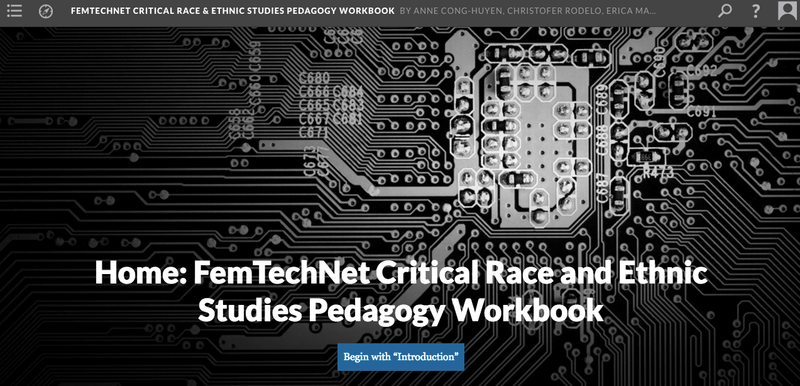Getting a Sense of the Place: Navigating FemTechNet’s Critical Race and Ethnic Studies Workbook
George Hoagland, Minneapolis College of Art and Design;Veronica Paredes, University of Illinois at Urbana-Champaign; Ann Wu, University of Illinois Urbana Champaign
Boston 2017: Pedagogy

The FemTechNet Critical Race and Ethnic Studies Workbook is a Scalar publication that provides scholarly resources for students, educators, activists, and community members. Using Scalar’s authoring and media management platform, FemTechNet’s Critical Race and Ethnic Studies (CRES) Committee builds and maintains this publication for use by members of the FTN community as well as for those who work in broader educational contexts. A collective effort, the Workbook serves as one work site for those in the network whose research and interests revolve around issues of race and other intersectional categories as they emerge within feminism and technology discourses. As a live publication, the book changes as authors contribute to it and organize its content. The book is thus configured with internal and external uses in mind; it locates FTN members within critical race and ethnic studies discourses and offers public-facing pedagogy for a variety of uses. This ‘Making & Doing’ presentation offers three ways to navigate the Critical Race and Ethnic Studies Workbook (as author, teacher, and student), and investigates some of the challenges inherent to working with technology while thinking through structural inequalities associated with discourses of embodiment. Scalar’s unique navigational system, which offers users the freedom to devise numerous interactive pathways through media-rich publications, provides another layer to the Workbook’s pedagogical and disciplinary mission. Each visitor to the book must use ‘paths’ or ‘tags’ to decide how to proceed through its contents. These improvisational strategies mean that each author, reader, and user must find her own way through the place. Because the platform is designed to operate recursively, asymmetrically, and rhizomatically, it’s easy to ‘get lost’ in it. The CRES Committee argues that the kinds of sensory experiences that anchor the book (reading, watching, listening, clicking through, scaling up or down, etc.) are amplified by the content within it; every user must negotiate her own sensibilities around inclusion, abilities, cultures, geographies, languages, and histories as she works through the material, whether as an author, student, activist, or teacher. To understand what the book is for is to get a sense of one’s own place within its included discourses, as well as to place those discourses in the realms of one’s own environment. Ultimately, having to navigate the book makes each participant an active discussant, and the work and mission of the FemTechNet collective — as a network of distributed scholars focused on feminist interventions in technology — is replicated in the Scalar model. The CRES Committee sees this work as an important contribution to STS scholarship because it acknowledges the unfair burden that scholars and designers of color bear in representing institutional diversity and challenging preconceived notions of where and to what extent such diversity exists. CRES also recognizes that STS scholarship on race and ethnicity is a growing area of focus for practitioners and a developing commitment in feminist pedagogy.
Published: 01/30/2023
